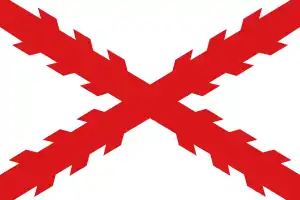Captaincy General of Santo Domingo
Santo Domingo, officially the Captaincy General of Santo Domingo (Spanish: Capitanía General de Santo Domingo pronounced [kapitaˈni.a xeneˈɾal ðe ˈsanto ðoˈmĩnɣo] (![]() listen)) was the first colony established in the New World under Spain in 1492. The island was named "La Española" (Hispaniola) by Christopher Columbus. In 1511, the courts of the colony were placed under the jurisdiction of the Real Audiencia of Santo Domingo.
listen)) was the first colony established in the New World under Spain in 1492. The island was named "La Española" (Hispaniola) by Christopher Columbus. In 1511, the courts of the colony were placed under the jurisdiction of the Real Audiencia of Santo Domingo.
Captaincy General of Santo Domingo Capitanía General de Santo Domingo | |||||||||||||||
|---|---|---|---|---|---|---|---|---|---|---|---|---|---|---|---|
| 1493–1795 | |||||||||||||||
_Pillars_of_Hercules_Variant.svg.png.webp) Colonial coat of arms of the Kings of Spain.
| |||||||||||||||
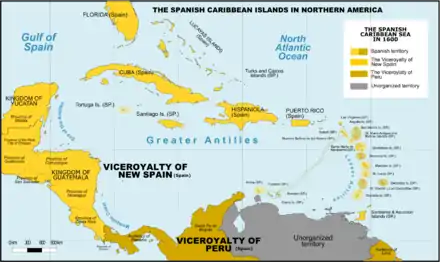 Spanish Caribbean around 1600. The Captaincy General of Santo Domingo in the center. | |||||||||||||||
| Status | Colony of Spain | ||||||||||||||
| Capital | Santo Domingo | ||||||||||||||
| Common languages | Spanish | ||||||||||||||
| Religion | Catholic | ||||||||||||||
| Government | Monarchy | ||||||||||||||
| King | |||||||||||||||
• 1493–1516 | Ferdinand II and Isabella I (first) | ||||||||||||||
• 1788–1795 | Charles IV (last) | ||||||||||||||
| Governor | |||||||||||||||
• 1493–1500 | Christopher Columbus (First) | ||||||||||||||
• 1788–1801 | Joaquín García y Moreno (Last) | ||||||||||||||
| History | |||||||||||||||
• Human settlement | Before 1493 | ||||||||||||||
• European settlement | 1493 | ||||||||||||||
• Treaty of Ryswick, ceded western portion to France | 1697 | ||||||||||||||
• Peace of Basel, ceded eastern portion to France | 1795 | ||||||||||||||
| Area | |||||||||||||||
| 54,642 km2 (21,097 sq mi) | |||||||||||||||
| Currency | Santo Domingo real | ||||||||||||||
| |||||||||||||||
| Today part of | |||||||||||||||
Part of a series on the |
|---|
| History of the Dominican Republic |
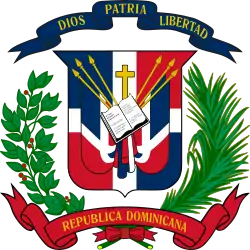 |
| Pre-Spanish Hispaniola (-1492) |
| Captaincy General of Santo Domingo (1492-1795) |
| French Santo Domingo (1795–1809) |
| España Boba (1809-1821) |
| Republic of Spanish Haiti (1821-1822) |
| Republic of Haiti (1822-1844) |
| First Republic (1844-1861) |
|
|
| Spanish occupation (1861-1865) |
| Second Republic (1865-1916) |
| United States occupation (1916-1924) |
| Third Republic (1924-1965) |
| Fourth Republic (1966-) |
| Topics |
|
Military history Postal history Jewish history |
|
|
The Captaincy General of Santo Domingo had an important role in the establishment of Latin American colonies in the Western Hemisphere. It was the headquarters for Spanish conquistadors on their way to the conquest of the mainland due to its strategic location. It is the site of the first city in the Americas with the oldest castle, fortress, cathedral, and monastery in the region. The colony was a military stronghold of the Spanish Empire for over a century, being a base upon which military expeditions were launched elsewhere.
In the early 17th century French pirates took over part of the west coast and French settlers arrived soon thereafter. After decades of armed conflicts, Spain finally ceded the western third of Hispaniola to France in the Treaty of Ryswick in 1697, thus establishing the basis for the later national divisions between the Dominican Republic and Haiti.
1492–1539: arrival of the Spanish
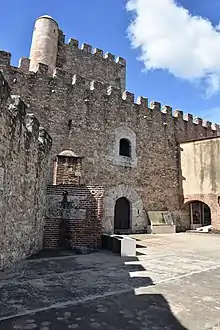
Prior to the arrival of Christopher Columbus and the Spanish in 1492, the native Taíno people populated the island which they called Quisqueya (mother of all lands) and Ayiti (land of high mountains), and which the Spanish later named Hispaniola. At the time, the island's territory consisted of five chiefdoms: Marién, Maguá, Maguana, Jaragua, and Higüey.[1] These were ruled respectively by caciques (chiefs) Guacanagarix, Guarionex, Caonabo, Bohechío, and Cayacoa.

In 1493, Columbus came back to the island on his second voyage and founded the first Spanish colony in the New World, the city of Isabella. In 1496, his brother Bartholomew Columbus established the settlement of Santo Domingo de Guzmán on the southern coast, which became the new capital. An estimated 400,000 Tainos living on the island were soon enslaved to work in gold mines. By 1508, their numbers had decreased to around 60,000 because of forced labor, hunger, disease, and mass killings. By 1535, only a few dozen were still alive.[2]
Dating from 1496, when the Spanish settled on the island, and officially from 5 August 1498, Santo Domingo became the first European city in the Americas. Bartholomew Columbus founded the settlement and named it La Nueva Isabela, after an earlier settlement in the north named after the Queen of Spain Isabella I.[3] In 1495 it was renamed "Santo Domingo", in honor of Saint Dominic. Santo Domingo came to be known as the "Gateway to the Caribbean" and the chief town in Hispaniola from then on.[4] Spanish Expeditions which led to Ponce de León's colonization of Puerto Rico, Diego Velázquez de Cuéllar's colonization of Cuba, Hernando Cortes' conquest of Mexico, and Vasco Núñez de Balboa's discovery of the Pacific Ocean were all launched from Santo Domingo.
In June 1502,[5] Santo Domingo was destroyed by a major hurricane, and the new Governor Nicolás de Ovando had it rebuilt on a different site on the other side of the Ozama River.[6][7] The original layout of the city and a large portion of its defensive wall can still be appreciated today throughout the Colonial Zone, declared a World Heritage Site by UNESCO.
Diego Colon arrived in 1509, assuming the powers of Viceroy and admiral. In 1512, Ferdinand established a Real Audiencia with Juan Ortiz de Matienzo, Marcelo de Villalobos, and Lucas Vazquez de Ayllon appointed as judges of appeal. In 1514, Pedro Ibanez de Ibarra arrived with the Laws of Burgos. Rodrigo de Alburquerque was named repartidor de indios and soon named visitadores to enforce the laws.[7]:143–144,147
During this period, the colony's Spanish leadership changed several times. When Columbus departed on another exploration, Francisco de Bobadilla became governor. Settlers' allegations of mismanagement by Columbus helped create a tumultuous political situation. In 1502, Nicolás de Ovando replaced de Bobadilla as governor, with an ambitious plan to expand Spanish influence in the region. It was he who dealt most brutally with the Taíno people.
One rebel, however, successfully fought back. Enriquillo led a group who fled to the mountains and attacked the Spanish repeatedly for fourteen years. The Spanish ultimately offered him a peace treaty and gave Enriquillo and his followers their own city in 1534. The city lasted only a few years. Rebellious slaves burned it to the ground and killed all who stayed behind.
In 1501, the Spanish monarchs, Ferdinand I and Isabella, first granted permission to the colonists of the Caribbean to import African slaves, which began arriving to the island in 1503. In 1510, the first sizable shipment, consisting of 250 Black Ladinos, arrived in Hispaniola from Spain. Eight years later African-born slaves arrived in the West Indies. Sugar cane was introduced to Hispaniola from the Canary Islands, and the first sugar mill in the New World was established in 1516.[8] The need for a labor force to meet the growing demands of sugar cane cultivation led to an exponential increase in the importation of slaves over the following two decades. The sugar mill owners soon formed a new colonial elite, and initially convinced the Spanish king to allow them to elect the members of the Real Audiencia from their ranks. Poorer colonists subsisted by hunting the herds of wild cattle that roamed throughout the island and selling their hides.
The enslaved population numbered between 20,000 and 30,000 in the mid-sixteenth century and included mine, plantation, cattle ranch, and domestic laborers. A small Spanish ruling class of about 1,200 monopolized political and economic power, and it used ordenanzas (laws) and violence to control the population of color.
The first major slave revolt in the Americas occurred in Santo Domingo during 1522, when enslaved Muslims of the Wolof nation led an uprising in the sugar plantation of admiral Don Diego Colon, son of Christopher Columbus. Many of these insurgents managed to escape to the mountains where they formed independent maroon communities. By the 1530s, maroon bands had become so numerous that in rural areas the Spaniards could only safely travel outside their plantations in large armed groups. By 1545, there were an estimated 7,000 maroons beyond Spanish control on Hispaniola. The Bahoruco Mountains were their main area of concentration, although Africans had escaped to other areas of the island as well. From their refuges, they descended to attack the Spanish.
One preeminent leader of slave revolts was Sebastián Lemba. By directing a strategy of mobile, hit-and-run warfare, Lemba succeeded in resisting and evading the colonial forces for all of 15 years. Burning and sacking their way from Higüey to Yaguana, Lemba's group of guerrilleros negros evaded the Spanish authorities until 1547, the year in which the troops captured and executed the rebel leader, hanging his severed head from a gateway as an example to others who would dare disobey their white masters. Slave insurrections continued through the mid-century. As accounts indicate, slave revolts in the colony of Santo Domingo anticipated Saint-Domingue's uprisings by some 267 years.[9]
1540–1795
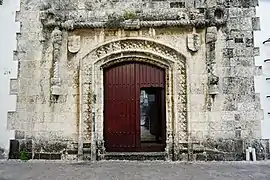
By the 1540s, the Caribbean Sea had become overrun with French pirates. In 1541, Spain authorized the construction of Santo Domingo's fortified wall, and decided to restrict sea travel to enormous, well-armed convoys. In another move, which would destroy Hispaniola's sugar industry, Havana, more strategically located in relation to the Gulf Stream, was selected as the designated stopping point for the merchant flotas, which had a royal monopoly on commerce with the Americas. With the conquest of the Spanish Main, Hispaniola slowly declined. Many Spanish colonists left for the silver-mines of the American mainland, while new immigrants from Spain bypassed the island. Agriculture dwindled, new imports of slaves ceased, and white colonists, free blacks and slaves alike lived in poverty, weakening the racial hierarchy and aiding miscegenation, which resulted in a population of predominantly mixed Spaniard, African, and Taino descent. Except for the city of Santo Domingo, which managed to maintain some legal exports, Dominican ports were forced to rely on contraband trade, which, along with livestock, became the sole source of livelihood for the island dwellers.
In 1586, Francis Drake captured the city and held it for ransom.[10] Drake's invasion signaled the decline of Spanish dominion over Hispaniola, which was accentuated in the early 17th century by policies that resulted in the depopulation of most of the island outside of the capital. An expedition sent by Oliver Cromwell in 1655 attacked the city of Santo Domingo, but was defeated. The English troops withdrew and took the less guarded colony of Jamaica, instead.[11] In 1697, the Treaty of Ryswick included the acknowledgement by Spain of France's dominion over the Western third of the island, now Haiti.
In 1605, Spain, unhappy that Santo Domingo was facilitating trade between its other colonies and other European powers, attacked vast parts of the colony's northern and western regions, forcibly resettling their inhabitants closer to the city of Santo Domingo.[12] This action, known as the devastaciones de Osorio, proved disastrous; more than half of the resettled colonists died of starvation or disease.[13] The city of Santo Domingo was subjected to a smallpox epidemic, cacao blight, and hurricane in 1666; another storm two years later; a second epidemic in 1669; a third hurricane in September 1672; plus an earthquake in May 1673 that killed two dozen residents.[14] San José de Ocoa, the best-known maroon settlement in Santo Domingo, was subjugated by the Spanish in 1666.
In the 17th century, the French began occupying the unpopulated western third of Hispaniola. Intermittent clashes between French and Spanish colonists followed, even after the 1697 Treaty of Ryswick recognized the de facto occupations of France and Spain around the globe. Periodic confrontations also continued despite a 1731 agreement that partially defined a border between the two colonies along the Massacre and Pedernales rivers. In 1777, the Treaty of Aranjuez established a definitive border between what Spain called Santo Domingo and what the French named Saint-Domingue, thus ending 150 years of local conflicts and imperial ambitions to extend control over the island.[15]
The House of Bourbon replaced the House of Habsburg in Spain in 1700 and introduced economic reforms that gradually began to revive trade in Santo Domingo. The crown progressively relaxed the rigid controls and restrictions on commerce between Spain and the colonies and among the colonies. The last flotas sailed in 1737; the monopoly port system was abolished shortly thereafter. Many Spaniards and Hispaniola-born Creoles also then became pirates and privateers. By the middle of the century, the population was bolstered by emigration from the Canary Islands, resettling the northern part of the colony and planting tobacco in the Cibao Valley, and importation of slaves was renewed. Santo Domingo's exports soared and the island's agricultural productivity rose. This progress in the Spanish part was assisted too by the war that broke out in 1762 between Britain and her ally Portugal against France and Spain, for the Dominican Spaniards hastened to resort to a calling with which they were by this time well familiarised,[16] and their privateers soon waged injurious war upon the commerce of the British in the West Indian waters,[16] the prizes they took being carried to Santo Domingo, where cargoes were sold to the inhabitants, or to foreign merchants doing business there. The slave population of the Spanish part by this means was also much increased, as many prisoners were taken from the slavers in those waters.[16] The author of Idea del valor de la Isla Española emphasizes the name of Captain Lorenzo Daniel (Lorencín), and notes that “he was the scourge of the British, whom he deprived of more than 60 ships, those used for trade as well as war.”[Note 1]
The population of Santo Domingo grew from about 6,000 in 1737 to approximately 125,000 in 1790. Of this number, about 40,000 were white[Note 2] landowners, about 25,000 were black or mulatto freedmen, and some 60,000 were slaves. However, it remained poor and neglected, particularly in contrast with neighboring French Saint-Domingue, which became the wealthiest colony in the New World.[19] As restrictions on colonial trade were relaxed, the colonial elites of St. Domingue offered the principal market for Santo Domingo's exports of beef, hides, mahogany and tobacco. With the outbreak of the Haitian Revolution, the rich urban families linked to the colonial bureaucracy fled the island, while most of the rural hateros (cattle ranchers) remained, even though they lost their principal market. Spain saw in the unrest an opportunity to seize all, or part, of the western region of the island in an alliance of convenience with the rebellious slaves. The Spanish governor of Santo Domingo purchased the allegiance of important black leaders and their personal armies.[20] In July 1793, Spanish forces, including former slaves, crossed the border and pushed back the disheveled French forces before them.[20] Although the Spanish had had much their own way in northern Saint-Domingue,[20] such had not been the case in Europe, and on July 22, 1795, the French Republic and Spanish crown signed the Treaty of Basle. Frenchmen were to return to their side of the Pyrenees in Europe and Santo Domingo was to be ceded to France. This period called the Era de Francia, lasted until 1809 until being recaptured by Spain.
Gallery
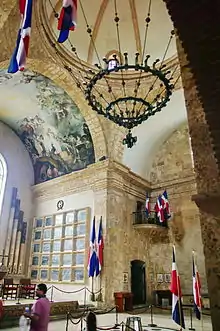 National pantheon.
National pantheon.
 Contemporary map showing the border situation on Hispaniola following the Treaty of Aranjuez
Contemporary map showing the border situation on Hispaniola following the Treaty of Aranjuez
See also
Notes
- During the war of 1762, a packet boat, a brigantine, six sloops, two schooners, and a coastal vessel were brought into port and it was Dominican corsairs, Lorenzo Daniel, Juan Bautista San Marcos, Juan Cueto, and Domingo Alberto Serrano who brought them in.[17]
- “Whites” included light mulattoes.[18]
References
- Perez, Cosme E. (20 December 2011). Quisqueya: un país en el mundo: La Revelacin̤ Maya Del 2012. Palibrio. p. 27. ISBN 978-1-4633-1368-5. Retrieved 4 June 2012.
- Hartlyn, Jonathan (1998). The Struggle for Democratic Politics in the Dominican Republic. Chapel Hill: University of North Carolina Press. p. 25. ISBN 0-8078-4707-0.
- Greenberger, Robert (1 January 2003). Juan Ponce de León: The Exploration of Florida and the Search for the Fountain of Youth. The Rosen Publishing Group. p. 35. ISBN 978-0-8239-3627-4. Retrieved 4 June 2012.
- Bolton, Herbert E.; Marshall, Thomas Maitland (30 April 2005). The Colonization of North America 1492 to 1783. Kessinger Publishing. p. 17. ISBN 978-0-7661-9438-0. Retrieved 4 June 2012.
- Clayton, Lawrence A. (25 January 2011). Bartolom de Las Casas and the Conquest of the Americas. John Wiley & Sons. p. 19. ISBN 978-1-4051-9427-3. Retrieved 4 June 2012.
- Meining 1986:9
- Floyd, Troy (1973). The Columbus Dynasty in the Caribbean, 1492-1526. Albuquerque: University of New Mexico Press. pp. 55, 73.
- Sharpe, Peter (1998-10-26). "Sugar Cane: Past and Present". Archived from the original on 2008-05-18. Retrieved 2008-07-15.
- Haitian-Dominican Counterpoint: Nation, State, and Race on Hispaniola. p. 32.
- "Dominican Republic – THE FIRST COLONY". Library of Congress. Retrieved 2009-03-18.
- Marley, David (1998). Wars of the Americas. ABC-CLIO. pp. 148–149. ISBN 9780874368376.
- Knight, Franklin W. (1990). The Caribbean: The Genesis of a Fragmented Nationalism (2nd ed.). New York: Oxford University Press. pp. 54. ISBN 0-19-505440-7.
- Harvey, Sean (2006). The Rough Guide to the Dominican Republic (3rd ed.). New York: Rough Guides. pp. 352. ISBN 1-84353-497-5.
- Marley, David (2005). Historic Cities of the Americas: An Illustrated Encyclopedia, Volume 2. ABC-CLIO. p. 94.
- Africana: The Encyclopedia of the African and African American Experience. p. 422.
- Hazard, Samuel (1873). Santo Domingo, Past And Present; With A Glance At Haytl. p. 100.
- Bosch, Juan (2016). Social Composition of the Dominican Republic. Routledge. p. 101.
- Ricourt, Milagros (2016). The Dominican Racial Imaginary: Surveying the Landscape of Race and Nation in Hispaniola. Rutgers University Press. p. 64.
- "Dominican Republic—The First Colony". U.S. Library of Congress. Retrieved 2008-07-15.
- Scheina, Robert L. (2003). Latin America's Wars: Volume 1. Potomac Books.
Further reading
- "Santo Domingo". Encyclopædia Metropolitana. 18. London: B. Fellowes et al. 1845. hdl:2027/mdp.39015082485213.
